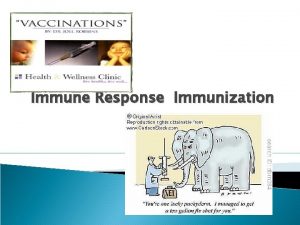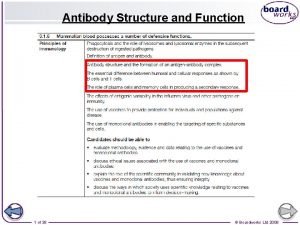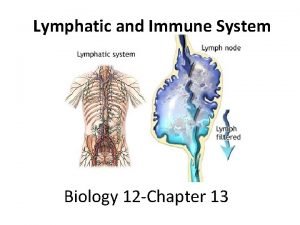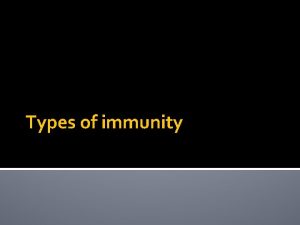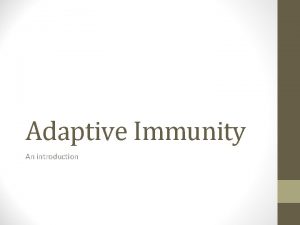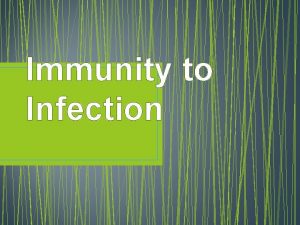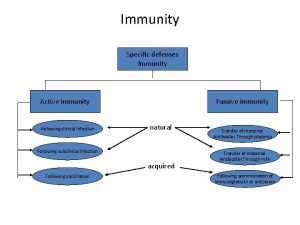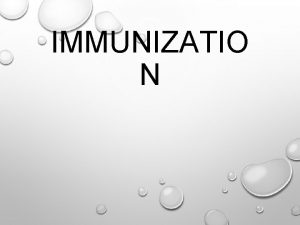Passive Immunity Two types of immunity passive and









- Slides: 9

Passive Immunity � Two types of immunity: passive and active. � Immunity acquired by receiving antibodies from a source other than one’s own immune system. � This type of immunity is temporary, not lifelong. � Newborns can receive antibodies from breast milk, which helps protect newborns before their own immune systems have fully developed. � Can also be artificially acquired.

Active Immunity � Immunity that your own immune system creates. � Results from either having a disease or from receiving a vaccine. � Vaccines contain small amounts of dead or modified pathogens or their toxins. � Most vaccines are given to children.

Active Immunity �A vaccine causes your immune system to produce antibodies against the pathogen, as if you had actually been infected. � You develop immunity without having to experience the disease. � After a few years, you may receive a booster dose of some vaccines to “remind” your immune system to maintain your immunity.

Bacterial Diseases � Despite all your body’s defenses, occasionally pathogens are able to enter your body and cause disease. � In most cases your immune system is able to defeat the illness. � Of the thousands of infectious diseases, about 40 commonly occur in the U. S. � We will discuss 4 of them

Strep Throat �A bacterial disease that is common among teens. � Strep bacteria, which are usually found in the nose and throat, can be spread by contact with mucus from an infected person. � Symptoms include: sore throat, swollen lymph nodes, headache, fever,

Lyme disease � Can be infected when bitten by an infected tick. � Symptoms include: red rash at the site of the tick bite, fever, chills, and body aches. � The best prevention for Lyme disease is to avoid tick bites. � This can be done by wearing long sleeves, long pants, and tucking your pants into your socks.

Bacterial Meningitis � An infection of the fluid in the spinal cord and the fluid that surrounds the brain. � Symptoms include: high fever, headache, vomiting, and a stiff neck. � There are two types of meningitis, one is caused by a virus the other by bacteria. � Early treatment of bacterial meningitis is critical to prevent serious illness and death.

Tuberculosis �A highly contagious infection of the lungs. � Is transmitted when droplets from an infected person’s cough or sneeze are inhaled. � Symptoms include: fatigue, weight loss, a mild fever, and constant cough, and may not show up for many years after the initial infection. � 1/3 of the worlds population is infected with TB, and nearly 2 million die each year.

Treating Bacterial Infections � Usually treated with an antibiotic. � These can only be purchased with a prescription. � Using antibiotics exactly as they are prescribed is extremely important to prevent bacteria from developing resistance to the medicine.
 Difference between acquired immunity and innate immunity
Difference between acquired immunity and innate immunity Immunity assignment slideshare
Immunity assignment slideshare Active vs passive immunity
Active vs passive immunity Passive immunity
Passive immunity Cellular immune response
Cellular immune response Naturally acquired passive immunity definition
Naturally acquired passive immunity definition Example of artificial passive immunity
Example of artificial passive immunity Humoral and cell mediated immunity difference
Humoral and cell mediated immunity difference Chapter 13 lymphatic system and immunity
Chapter 13 lymphatic system and immunity Chapter 16 lymphatic system and immunity
Chapter 16 lymphatic system and immunity





